|
New metaphors for sustainability: metaphors for the continuation of life Over the next weeks, we are asking artists, scientists, activists and cultural commentators to suggest a metaphor for sustainability. Their suggestions will be posted on Ashdenizen, and all the metaphors will be compiled here.
The people we've asked:
Ansuman Biswas |
Ruth Little |
James Marriott |
Monik Gupta |
The Institute for the Art and Practice of Dissent at Home | Alison Parfitt | David Haley | Hester Reeve | Zoë Svendsen | Mario Petrucci | Francesca Galeazzi | Carolyn Steel | Bradon Smith | Caspar Henderson | Amanda Thomson | Nick Robins | Sue Palmer | Peter Harrison | David Harradine | Annie Cattrell | Wallace Heim | Alison Turnbull | Solitaire Townsend |
The metaphors they've suggested:
the act of breathing | the Spiderweb Tapestry | the sailboat | the shopping divider at the check-out | water on a fire - helping turn the page - a child asleep - the family - failing better | my sweet pea | art & grace | "Come into my house." (DVD) | symbiosis | mercury | an indigenous tribe of the Amazon | the timeless meal |
Le Tour | coral reef | the Kelo | 'A matter of time' | song | the yew tree | the soil in my family’s garden in Yorkshire | the Fetch (of a wavelength; to collect) | a stranger's compass | the Spanish Dehesa |
teenaged sex, Tatiana's 'weather speech', advice to the dude |
Ansuman Biswas, artist
the act of breathing
I can't imagine something that sustains forever and the notion of an endpoint isn’t there in the idea of sustainability. We're talking about something that's eternal, and I don't know anything that is eternal. I can't imagine eternity. The word itself, from the Latin sustenir, means to hold something up. It's as if there's some magical wish to hold up against gravity.
The image I keep coming back to is the image of the breath with its inherent balance, and the craziness of trying to breathe in forever. It's necessary also to let go, to recognise the limits of my ribcage, the limits of my diaphragm and body to hold any breath. And in letting go, in breathing out, I speak and sing to the world, and make a contribution that is unique to this body. What is sustained is the song, is the music. It has to be let go of and given. It's that music, that note, that for me, sustains. Ansuman is included in our film.
Ruth Little, dramaturg, writer, Associate Director Cape Farewell
the Spiderweb Tapestry

Photo: Godley & Peers |
The interweaving
This is a tapestry woven from the webs of a million Golden Orb spiders in Madagascar. I read about it in Nature, and went to see it in the American Museum of Natural History, New York. The project was conceived and led by Simon Peers and Nicholas Godley, using technology designed by French missionaries Jacob Paul Cambou and M. Nogu in Madagascar in the late nineteenth century. Delicately held in tiny 'stalls', the spiders collected from telegraph poles by 70 local people were 'milked'by hand each day and released. Each spider produced 80 feet of golden filament, which was spun and woven by local craftspeople over four years. It's an astonishingly beautiful, perhaps miraculous, work of art.
Whose art, though, is responsible for the tapestry? So many makers came together
to spin this intricate traditional pattern from a natural substance stronger than steel, and a million of them were spiders. It's my metaphor for integralism, resilience and the cooperative values underlying sustainable living.
Universal nature/human nature: The woven web
The spiderweb tapestry begins with the web itself - that global symbol of complexity and interconnection - and adds to it the specifically human dimensions of culture, tradition, stewardship and imagination. Produced with a combination of curiosity, great care, local knowledge and local resources, it is at once organic and mysterious; fabricated and wild, particular and universally evocative. It literally glows: it contains the 'vital materialism' described by Jane Bennett in her account of the active participation of non-human forces in events. Like Bennett, my metaphor seeks to develop and transform our sense of care in relation to both the human and the non-human world, 'to encourage more intelligent and sustainable engagements with vibrant matter and lively things.'
Virtually all of earth's natural systems have now been influenced and to some extent deranged by human modes of production and consumption. We have begun to cross the threshold of catastrophic loss, compelled by an appetite that has its origins in the relatively recent intellectual separation of human nature from the matter-energy continuum of which we have always been part.
We may have been expelled from Eden for mismanagement, but the whole earth is now our home, and we have nowhere else to go. Only active, attentive and responsible stewardship of earth's living systems and the natural capital on which we rely entirely for survival will make the fabric we're woven into resilient enough to survive the shocks it's now subject to.
The Madagascan tapestry is a work of ethical ingenuity: drawing on the self-organising tendencies of the non-human world, it combines the exceptional capacities of human hands and human minds to create something much more valuable - in cultural and ecological terms - than the sum of its parts.
James Marriott, artist and activist, PLATFORM
the sailboat
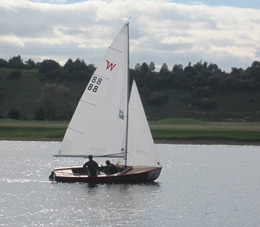
sailboat on the upper Thames |
The boat for me is a very powerful metaphor. Sustainability is a rather grey and unclear term, but if it means anything, it means that we have to live with the finite resources of the earth. We have to deal with this in our generation and pass it on to future generations.
It is this sense of the finite capacity that I find interesting and comes to me through the experience of boats. I mean boats which are driven by sail and by oar – that use the motive power of the wind and the tide captured through wood and flax and hemp and use that to move from ‘a’ to ‘b’.
I’ve been learning to sail, and it’s been a wonderful experience. It makes you extremely aware of the forces of nature – it makes it very intimate. You’re at the mercy of the winds. You have to work with the tides – the skill comes from using whatever is there, that finite amount of power.
The finiteness, too, comes from the space of the boat itself. You have to pack everything in it that you might need or want. The boat frames my needs and desires about where I can go and how long it’s going to take me.
It concentrates the mind about the nature of the space in which I'm in, and about the wind and the water and the movement of the tide and the flow of the river.
James is included in our film.
Monik Gupta, environmental blogger:Öko-Fakt, researcher
the shopping divider at the check-out
For me, thinking about sustainability, the object in the picture comes to mind. We come across it so regularly, however there is no word readily available to us to describe it (google suggests it to be termed 'cashier divider' by retail experts). Evidently, just like with 'sustainability', it is something very well known but much less engaged with.
What's more important, both the shopping divider and sustainability mark the necessity for confinement of our own consumption and draw attention to others' needs.
Maybe those two points, shallow engagement despite omnipresence and a focus on limitations of our consumption, are related. We are reluctant to make explicit the distinction between our needs and those of others, even though we are acutely aware of its necessity. However, this is exactly where the beauty of both the 'shopping divider' and 'sustainability' could lie: in marking the confines of our needs, they enable us to direct attention to our fellow human beings. We begin to acknowledge that we are 'in this together', urgently needing to demonstrate our 'ability to sUStain'.
The Institute for the Art and Practice of Dissent at Home, two adults and three children in Everton, Liverpool
water on a fire | helping turn the page | a child asleep | the family | failing better
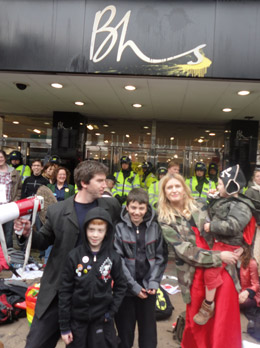
clockwise from top left: Gary, Lena, Sid, Neal, Gabriel |
Neal (aged 10): The world is big plank of wood and it's on fire. The only thing to save it is water. Sustainability is water - that's what it is.
Gabriel (aged 8): It's a big round book, the world is a big circular book, but it needs help to turn the next page, it can't do it by itself so we all have to help the big book turn its next page. That's sustainability – helping to turn the page.
Sid (aged 3): (Sid was asleep on the couch when we asked him. That struck a chord with us. Sustainability is Sid asleep, rapid eye movements, visceral dreaming, thoughts shooting round his brain, wiring and rewiring the connectors in his head, trying to sort out what happened today ready for some sort of tomorrow. But his body mass seems to rest, refuel. It digests its food, slowly, carefully, puts things in place biologically, mentally, spiritually even so that when he wakes up he'll have a good chance at getting what he needs and be in a good enough mood to share what he has with his mates at the nursery.)
Gary (aged 39): A family is the best metaphor I can think of for sustainability. Not the family that the Pope, in Croatia in June, said was in the midst of ruin under the new atheism of secularisation. But the queer family, the radical family, the family that doesn't depend upon or nurture conservative values and the endless reproduction of repressive ideologies. Rather a family that depends - indirectly - upon the reproduction of itself with difference. That's what having kids has been for us. They are us, with difference. You don't need to be a biological parent for this to happen. It happens everywhere through friendships, encounters and love affairs. It's the indirectness that is crucial. Indirectness at the heart of all family-making. It sounds a bit arty-farty to say it like that, but sustainability always has an element of indirectness about it. I won't actually suffer climate chaos in Bangladesh or the terrible local effects of the Alberta Tar Sands extraction, except indirectly. That's partly what makes it so tricky to get hold of. How can everyone act in solidarity with other people? The indirectness is what stops us. But we have to embrace the indirectness, like we embrace the difference that is produced in our own kids every day as they grow into and away from us. Embracing indirectness is the key for me, as a family-maker. It's the only way to be happy in the long-run. The relationship between me and my kids is the best metaphor I have for sustainability. Maybe because it's not even a metaphor but a living, loving struggle. If you haven't got kids, it's the same with your friends or your lovers or your students or your neighbours.
Lena (aged 36): sustainability is allowing difference, allowing impossible encounters to take place and surprise you. sustainability is being naughty. sustainability is getting out of the box you are in, getting out of networks you belong to, seeing beyond your own group. sustainability is travelling the world, learning a new language, but a really new language, a new method, a new skill. sustainability is beyond the local. sustainability is the provocation that stops you being righteous. fail. fail again. fail better. go for the impossible.
Alison Parfitt, writer and teacher, Wildlands Research Institute
my sweet pea
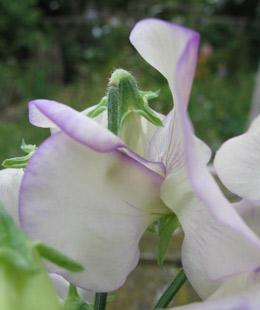
Photo: Alison Parfitt |
Sustainability. After the Rio Earth Summit in 1992, I was impassioned about this challenging aspiration, with head and heart. Many of us struggled over complicated diagrams, wanting to encompass everything. We talked about ecological systems and the need for the sacred and spiritual, the connectedness of all. We explored social and environmental justice and quality and equality – with diversity. Models and metaphors came and went, bees in a beehive.
Now I see this challenge of understanding the potential and power of sustainability in a more intimate way. And I suspect that the full and inspiring notion of sustainability (sometimes understood but often not) is showing a way, a direction for the human species to evolve, if we can.
As I write this there is a sweet pea, picked this morning, beside me. A soft fresh fragrance. This flower is creamy pale with a purple, or even nearing indigo, fine edging on the petals. It looks and feels precise, very clear yet fragile. It moves in the air coming through the door. The flower is here today but gone tomorrow, the plant goes on and I shall gather seed. It is everyday and uniquely precious.
I accept that my sweet pea may not be a helpful metaphor for sustainability, but for today, now, it enlightens me and reminds me of my relationship within all else, and how I could be more human. And that’s where my quest to understand has got to. I suspect it will move on again, soon.
David Haley, ecological artist
art & grace
art
The Sanskrit origin of the word ‘art’ is 'rta'. Originally appearing in the Rig Vedas, rta is still used in contemporary Hindi to mean the dynamic process by which the whole cosmos continues to be created, virtuously. This noun/adjective also means the right-handedness, righteousness, and the right way of doing things. Here we find remnants of that meaning in modern English in terms like 'the art of gardening', 'the art of football, 'the art of archery' and 'the art of war'. Rta conjugates into the verb 'ritu' (ritual) that refers to the correct order or sequence of rta (i.e. the cyclical pattern of the seasons, or the progression from seed to leaf and root to tree to blossom to seed). ‘Art’ may have lost much of its etymological meaning, but maybe it retains the potential to re-emerge as a metaphor for sustainability, like a flower waiting for rain in some future desert?
grace
This metaphor comes from my work with the artists The Harrisons, and is taken from their work The Lagoon Cycle: 'As the waters rise gracefully, how will we withdraw with equal grace?'
The difference between the Environment Agency's policy of 'managed retreat' in response to sea level rise and our proposals in the work ‘Greenhouse Britain: Losing Ground Gaining Wisdom’ was the EA’s use of engineering and war metaphors to confront a problem, compared with an ethical and aesthetic repositioning of the situation.
‘Tide Turns, Waters Dance’ was one of my own ‘Writing on the Wall’ pieces, this one exhibited in Taiwan. The last of the 27 Haiku-style poems ended with the line, 'water, time and grace'. When a Taiwanese professor quizzed me over the use of the word, 'grace' to end the work, I explained that a meaning of grace was 'becomingness'. 'Aha', he replied, 'so you hope to evolve beyond climate change?'
Hester Reeve (HRH.the), artist, lecturer
"Come into my house." (DVD)
The term 'sustainability' is rightly used first and foremost in the contexts of both local and global policy changes. Whilst acknowledging the crucial role played by activist pressure in ensuring sustainability is on the agenda in the first place, I see its implementation chiefly as the responsibility of politicians (shame on them).
I made my metaphor in my house. The camera is out on the street and I open each door/window in turn and call out for various thinkers to "Come into my house." As an artist, I am more interested in restoring richness to the 'cult' of everyday life and in incorporating the force of poetic imagination than in reflecting/interacting with culture at large. My metaphor therefore reflects this sensibility. I suppose the only thing someone like me at this point in the environmental direness of 2011 can do is to come back to the doorstep, where the agency of the single being starts and to call for that paradigm shift in our thinking that might finally allow us to dwell as an act of loving the world. Editors' note: Hester calls to Gilles Deleuze, Martin Heidegger, Alain Badiou, Plato, Jacques Derrida, Gyatri Spivak, Diogenes of Sinope, Giorgio Agamben, Frederich Neitzsche.
Zoë Svendsen, theatre director, researcher, Metis Arts
symbiosis
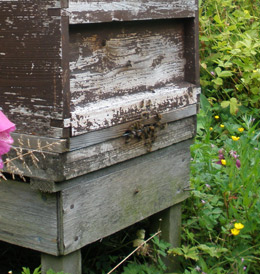
Photo: Wallace Heim |
When I was given the challenge of thinking about a metaphor for sustainability, I realized I didn’t really know what it was, other than the idea that maybe you shouldn’t do quite so much of something so that you could do things again in the future. But then I got to thinking about the underlying questions. What do we need to sustain? What’s the idea of sustainability? It’s linked to current discourses against consumption and to ideas about austerity and about doing less. What could you replace sustainability with as a metaphor that would allow you to do something as opposed to just not doing something? I was thinking about things like conversation and reciprocity and some kind of interaction with your environment that didn’t deny the pleasures of exchange and of use. I eventually arrived at the term ‘symbiosis’ and symbiotic thinking.
What’s interesting about the term 'symbiosis', is that as a metaphor it takes us away from the 'nature versus culture' idea or ‘human benefit versus benefit for nature or the environment', and rather asks us to think about how there might be certain kinds of human symbiotic interactions and at the same time benefits for the environment. The symbol for this kind of activity are bees, and bee-keeping. There can be a human relationship to these kinds of symbiotic practices that happen in the environment already – such as the spreading of pollen and the creating of honey. And around that word 'symbiosis', there’s a whole series of other underlying terms or thoughts that could be replaced. Instead of thinking about 'austerity' – which is a negative thinking towards the future - that we can always only do less and life isn’t going to be as good – you might replace that with 'ingenuity'. This celebrates invention and entrepreneurialism and thinks about what’s at hand and what possible in what may be limited circumstance but treats those circumstances as a pleasureable challenge. Part of the problem with austerity is that it makes you want to rebel.
I have occasional bouts of recycling rebellion – I go 'fuck it' and throw it away. 'I want to waste, I don’t want to be sensible'. This is something to do with the moral imperative around the idea of austerity – it’s just not fun. Part of the idea about ‘symbiosis’, is that you don’t have that same kind of moral anxiety around all of your actions. You’re directed to a positive action instead of endlessly thinking about the negative – which just makes you want to be naughty and not do it. Zoë is included in our film.
Mario Petrucci, poet, ecologist, physicist, essayist
mercury
My chief reservation about sustainability is that it can mean so many things to different interest groups. For one protagonist, sustainability may demand a massive redistribution of resources and wealth, coupled with radical reassessments of consumer values and economic practice; for another, it involves no more than modest adjustments to what we already do in order to accommodate a few of the most urgent ecological imperatives. As with Climate Change, then, there’s no overall consensus concerning the precise shape sustainability will take. ‘Sustainable forest’ can mean a rich and ancient woodland drawn upon occasionally but left mostly to its own devices, or it can be a perpetual pine plantation supplying wood pulp and with practically zero biodiversity in it. That’s why I’ve chosen mercury as a metaphor for sustainability. It challenges any assumption we might have that sustainability takes a uniform or consistent form among those considering it. The image of mercury scurrying across a surface is familiar to most people, and is apt here because it allows us to better grasp the current ungraspability of sustainability. Sustainability is a fraught and fugitive issue, beset by political and personal evasions and manoeuvrings. What’s more, the way in which sustainability can be made to adapt shape is both weakness and strength. On the negative side, if mercury is mishandled it becomes a toxic nuisance; likewise, sustainability can be distorted, misrepresented or misapplied, either through ignorance or cynically, to allow damaging practices to continue beneath a veneer of acceptability. On the positive side, if put to proper use in a careful and structured way, and if its complex nature is understood and worked with, sustainability also provides an extremely valuable, if not life-saving, tool. Mercury can communicate what the weather’s doing outside, or signal the degree of fever in the human body; sustainability, too, could be harnessed to monitor and sustain the wellness of our species in relation to its environment. Either that, or we can let the concept mess with our brains and slip through our fingers.
Francesca Galeazzi, sustainability engineer and artist
an indigenous tribe of the Amazon

Photo © Indigenous People's Cultural Support Trust |
I underestimated the amount of time and thinking that it would take to come up with a metaphor that I am happy with. Sustainability is not only something that I care about, but it is also extremely difficult to pin down to something specific. It holds many facets and most are often equally important!
Having said this, I still believe that diversity is key to sustainability.
Ecosystems rely on a complex set of relationships and the interdependence of diverse species and creatures to sustain themselves. This is the basis of all life on our planet and applies to flora and fauna, as well as society and culture. However, the current aggressive approach to global development that we have experienced in the last century is threatening diversity at all levels.
Visualising diversity is a difficult task. The first images that sprung to my mind were not too dissimilar to the United People of Benetton campaign in the 90’s, highlighting the beauty of multiculturalism. But how obvious it is! I also thought about cities, food, gardens, oceans, the coral reef - but none seemed really appropriate.
The metaphor that to me best evokes the idea of both ecological and social diversity is the Amazon, probably the most important biodiverse and rich ecosystem of our planet, under so much threat of irreversible change. But the image of that magnificent tropical rainforest is not sufficient to me to evoke the notion of sustainability; as a general metaphor I think it is too obvious and worn out.
I am instead choosing the image of an indigenous tribe of the Amazon. To me this conveys not only the ecological issues that rainforests around the world face today (deforestation, illegal logging, land exploitation, mining, etc) but also talks about that fundamental element that is societal diversity. Indigenous tribes, ethnic minorities and rural communities around the world represent a huge treasure of culture and unique heritage that is under increasing threat of disappearance. An indigenous tribe of the Amazon is a metaphor for all those ethnicities in the world under physical and cultural threat, and indirectly for their endangered environment, too. It is also a metaphor for knowledge and strength, for cultural richness and social resilience, for strong community cohesion, for respect and adaptability to the natural environment, all of which to me are the pillars of sustainability.
Carolyn Steel, food urbanist
the timeless meal
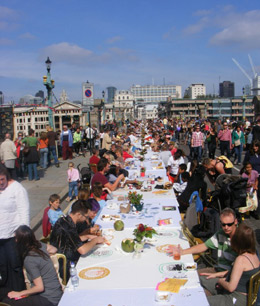
Feast on the Bridge, 2009
Curated by Clare Patey; Photo: Tim Mitchell |
What is it we’re trying to sustain? For me, the meal is the emblematic, wonderful situation that sums up the whole point of sustainability. I think in metaphor all the time and food has become this way of seeing the world not just in terms of 'how are we going to feed ourselves in future?' – this kind of doom and gloom thing - but also in terms of asking 'what kind of society is it that we are trying to create – as well as sustain?'.
When you talk about food, there’s a tendency to talk about ‘how much grain can you produce on that much land with that much water’. That’s very important, but you have to relate every conversation you have about food with the kind of life that you are talking about. It’s about a vision of society, an idea of the good life.
The table is a place where you don't just share food, but you share ideas, you share love, you share conversation.
It’s a beautiful metaphor of the kinds of things that we’re trying to sustain. It’s society. It’s ‘good life’ in every possible sense - not just good in terms of wonderful food – but also good in terms of the ethics of what you eat. If I am hungry I have a practical problem. If you are hungry, I have an ethical problem. This business of sitting around a table with other people, the decorum of the table, and the sharing food - it brings the social relevance of sustainability into the conversation. A timeless meal, a meal that is enjoyed through time that has a past that we all intuitively understand, but a future as well, sums up for me the idea that food is life on earth. Carolyn is included in our film.
Bradon Smith, research associate in the Geography department at the Open University, and AHRC research fellow on climate change for the Department for Culture, Media and Sport
Le Tour
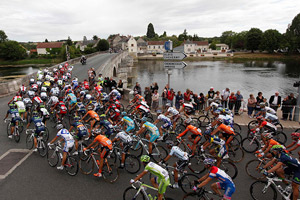
Tour de France, 2011, Stage 7 from Le Mans to Chateauroux,
crossing the Montrichard Bridge; Denis Balibouse/Reuters |
The bicycle is a wonderfully efficient and ecological mode of transport; and the dynamics of professional cycling are a model for the cooperation that real sustainability will require.
This week saw the climax of the Tour de France. Four hundred thousand people gathered on the mountain roads leading up to Alpe d'Huez to watch that one stage alone. Cycling works as a spectator sport partly because of the intense physical effort, but also because of the layers of tactics and teamwork: strength and stamina aren't enough to win the Tour. No rider could win the Tour without their team. Teamwork, co-operation and the team's different skills are required to win even a stage. Many of the members of a team (the domestiques) ride not for their own chances of glory, but for the benefit of another member of their team: setting the pace for their leading rider, carrying water for them, sheltering them from headwinds, and so on. These sacrifices are central to a team's success. Nor can any rider win any stage – some are more suited to mountains, others to flat stages. The rider who can achieve the fastest speeds (a sprinter) is unlikely to win the Tour, which requires a better all-round rider. Some teams are dedicated to the success of a single rider, others spread their efforts more widely. A team has to play to the strengths of its members. Despite the intense competition, and personal rivalries, there is a fundamental trust within the peloton. Hurtling along the road at 40mph, wheels within inches of one another, each rider must trust that the others will hold their line. And this trust has built a unique ethic: the peloton follows a set of unwritten rules. It is not done, for example, to profit from other riders' crashes – the peloton will wait instead. And the team of the leading rider is expected to do the most work, setting the pace for the whole peloton. Technological developments have dramatically affected cycling: bikes are lighter and more aerodynamic, and the riders are all equipped with radios for constant communication with their teams. Fans are divided over whether these changes are detrimental. But these developments have not drastically altered the basic ethic of the peloton. But there is another side to cycling. Teams are reliant on their corporate sponsors, and team tactics are also built around giving the most TV exposure to their sponsors' logos. Deals are done between riders of competing teams: 'you can have this win, if you help me tomorrow'. And – the big ones – doping blights the sport and fans speculate about deals and corruption at a high level. It isn't really clear how these problems will be eradicated; but in a sport shot through with the ethos of teamwork and cooperation, they strike right at its heart.
There is a temptation to 'cheat' with sustainability too: to greenwash and make tokenistic changes, but never integrate it fully into our lives and societies. But the cooperation that is central to professional cycling is also central to sustainability; as in a cycling team, one specialism will not be enough; and like in the peloton, we need to trust that others will also make the effort.
Caspar Henderson, writer and journalist
coral reef
As many people know, healthy tropical coral reef are among the the richest, most diverse and productive ecosystems on the planet, rivaled perhaps only by rainforests. It’s less widely appreciated, however, that this astonishing exuberance thrives in water that is very low in nutrients. The secret of the reef is that nutrients and materials are reused and recycled with great efficiency and rapidity in an almost closed loop.
Driving the cycle is sunlight, which is of course abundant in the tropics. Corals polyps, which are tiny animals, are able to build their layering and branching and skeletons (and thus over time the entire reef on which so much else depends) thanks to a partnership with photosynthetic algae called zooxanthellae, which harness energy from the sun and ‘feed’ their coral hosts in return for lodging. Whether or not you believe in the claims made for next generation nuclear power (and, like Amory Lovins and others, I have doubts), an economy that is able to run on energy directly harvested from the sun, store it where necessary and turn almost 100% of its wastes into assets looks like a good way to go.
Another familiar fact about coral reefs is that they are among the ecosystems in the world most vulnerable to human meddling. Our assaults come in various forms including direct ones such as destructive fishing practices and nutrient overload from sewage and agricultural runoff, and indirect ones such as rising global temperatures and ocean acidification caused by a rate of change in greenhouse gas concentrations not seen in millions of years. Coral reefs can, we now know, thrive within certain boundaries, and be remarkably resilient to some shocks so long as the boundaries are not crossed. Once they are, however, the whole system can very quickly tip over into a degraded state. The reef becomes choked with slime and the food web disintegrates into a rotting boneyard that supports a dwindling band of scavengers. Previous perturbations to the Earth system comparable to current human activity have resulted in mass extinction events from which it has taken reefs millions of years to recover. We’re not talking about a metaphor here so much as a 400lb gorilla already standing on our toes.
The good news, in a far as there is any, is that we have a pretty good feel for what must be done if the threats to reefs are to be sharply reduced. Some of the most important measures such as stabilization and then reduction in atmospheric greenhouse gas concentrations may look unachievable in the near term, but while we continue to struggle with those there are many other things that will also be necessary and on which progress can (and is) being made now. One such is the creation, with local community involvement, of networks of Marine Protected Areas.
A final, and for me the most important point about coral reefs is that they are places of stupendous beauty and wonder. Chances are these are not qualities that spring to mind when you think of sustainability. A more likely association might be something like ‘sensible shoes.‘ But sustainability does not have to be boring. It can and must be highly dynamic, just as a coral reef is: an arena for competition and struggle, yes, but an arena with limits and where new kinds of flourishing and cooperation are forever unfolding. Cruelty, suffering and death are not eliminated, but the scope for doing your own thing or doing something new - whether it be to bake cakes with five year olds, design new photovoltaic systems, or dance flamenco while dressed as a flamboyant cuttlefish - is greatly increased. photo: Gray Hardel/Corbis
Amanda Thomson, artist, researcher
the Kelo
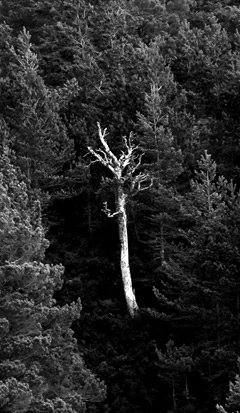
Photo: Amanda Thomson | For a few years now I have been spending a lot of time in some of the remnant Caledonia pine forests of Scotland, learning about their ecology, and making an ongoing piece of work called Dead Amongst the Living, which is ostensibly about the dead trees of these woodlands. Scots pines can live to be up to 300 years old, and even after they die, can stand for years before falling. In the middle of these woods, they sometimes stand pale like spectres amongst the greens, reds and browns of the living forest, and sometimes on the hills and moorlands of the north an occasional single tree reminds us of forests now long gone or the tenaciousness it has often taken to have survived.
There’s a Finnish word a ranger told me, Kelo, which describes a standing tree which has died, dried out in the wind and yet remains standing, often for decades, only quietly and imperceptibly decaying. Like the shells of old croft houses in the far north west and on the islands, such trees stand to remind us of a different past, and are testament to earlier times.
Dead wood supports a huge amount of biodiversity when still standing, and once they have fallen they continue to form a crucial part of the living ecosystems of a pinewood; indeed, it is said they support more species when dead than they do when alive. These dead trees contain microhabitats for species which are not found elsewhere but which are vital to the ongoing health of the forest. They are havens for invertebrates, hold rare mosses, provide nutrients for lichens, fungi and liverworts. At each stage of their decay, they give something back to their surroundings and support different species at different stages of decomposition. When standing, they provide viewpoints for raptors and their holes and cavities provide nest sites for a range of woodland birds, including crested tits. Their rot holes are used by the larvae of rare hoverflies, green shield-moss grows on old stumps and capercaillie use the upturned root plates of the fallen for cover and for dust baths. Eventually, over a period of years, and by being broken down in a variety of ways, all of the nutrients which have been stored in the tree will make their way back in to the earth and replenish it.
For me, these dead trees contain an essential reminder about how in both physical and in psychic terms, things that seem no longer with us, things that might appear to be useless and redundant, and things that becomes invisible can continue to influence, support and nourish the present, and the living, in ways that we might not yet know, but will perhaps, in time, come to realise.
Nick Robins, analyst in the policy, operational and financial dimensions of corporate accountability and sustainability, and writer
'A matter of time'

Achilles. Photo the British Museum |
In the end, sustainability is all about the allocation of the scarcest resource: time. How much time do we devote to what in the present, and how do we balance the imperatives of time past, time present and time future?
The task, then, is to defeat the ravages of geological time and transfer those things of value from one civilisation to the next, particularly now that we have passed during our lifetimes from the Holocene to the Anthropocene.
Nearly all of what we consider to be valuable in human society occupies a tiny fraction of our existence as a species (some 2 million years).
For me, Homer's Iliad is the archetype of human value across time. As the poet Christopher Logue discusses in the introduction to his recent interpretation, War Music, the Iliad is already a work that has survived the collapse of a number of civilisations through luck, persistence and care. But will it survive ours?
The Iliad was written perhaps in the 8th century BCE, some 2,800 years ago. For me, sustainability means enabling those in the future to have an equivalent chance to benefit from this fundamental text, constructing an arc into the future 2,800 years long. This means that my time horizon is (or should be) 4811 AD, far further out that the 2050 timelines of the climate negotiations or the 'seventh generation' thinking of the counter-culture.
The consequences of this shift in perspective are profound: we need to conceive sustainability as beyond culture and indeed language, as the transmission of value beyond time.
Sue Palmer, artist making live and digital work with people and place, and author of inquiline
song

Photo: Sue Palmer |
the extraordinary song:
often straightforward, yet infinitely complex
the diversity (how many millions have been created)
the particularity (each one individual)
a structure enabling brilliant inventivenessoften a voice and an instrument
two kinds of sounds, working
my musician friend John talks about chords as metaphors
about how two ‘discordant’ tones are shifted
through the addition of a third note, bringing resolve songs are free, and they can make someone a living
they help people make it through the day, and night
songs have changed peoples’ minds
a song can contain a lot of information, honed,
ideas packed in language,
rhythm, rhyme
there’s craft in it, and anyone can do it
there’s multiple ways to begin, and a sense when it’s complete
verse, chorus, verse, chorus, middle eight, chorus,
bridge
and key change, ‘ad lib to fade’
the pleasure of the repetition, letting the song free up, go
When I think of sustainability, I usually think of losing things, resources, capacity, and I find my materially-centred thought frustrating.
'If anything, I wanted to understand things and then be free of them. I needed to learn how to telescope things, ideas. Things were too big to see all at once, like all the books in the library - everything laying around on all the tables. You might be able to put it all into one paragraph or into one verse of a song if you could get it right', Bob Dylan, Chronicles, Volume One, 2004. photo: by Orelie Grimaldi of John Cartwright playing C#m7
Peter Harrison,
writer, artist and co-founder of Propeller Arts Collective
the yew tree
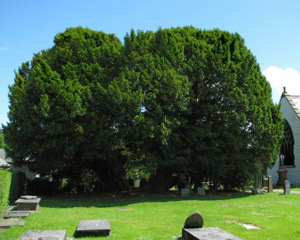
The Llangernyw Yew |
A simple definition of sustainability is the capacity to sustain. For me, this immediately poses a problem. I’m aware that everything comes to an end, nothing can go on forever. There’s something not quite real about the word, implying the possibility of being liberated from death. But also there are nurturing, practical, organic aspects to the word, implying maintenance and growth.
Trees are living processes. Yew trees live for centuries. Although it is difficult to accurately date yew trees, it is estimated that the Llangernyw Yew, in Conwy, Wales, is over four thousand years old. Yews are associated with immortality, renewal and transformation. Yews are living entities that sustain while the world around them changes. The yew in Conwy sheltered people from the early Bronze age. It is tempting to think that one of those people stood under the tree imagining life four thousand years in the future. As generations came and went, the tree continued. Yews represent the passage from life to death, and beyond, into the land of shadows.
The timeless quality of yew trees can also be personally experienced. Stepping into the low-hanging canopy of a yew, there is a marked change in temperature and volume. The air
is cool and still. The world is quieter. A space under branches. Natural sanctuaries in which to reflect, to slow down and contemplate life beyond the moment.
This is an uncertain world. In past centuries, when death was a more present, daily occurrence than it is now, maybe yews gave people hope that the world will continue. Hope that although one day we will die, part of the world we knew and loved will sustain.
David Harradine, artist working across performance, installation, publication and film, and Artistic Director of Fevered Sleep
the soil in my family’s garden in Yorkshire
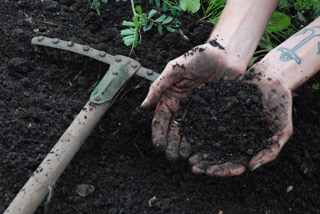
Photo: David Harradine |
We don’t even know what to call it, whether it’s soil or earth or dirt. 'Earthy' seems nourishing, homely, but we generally don’t like things that are dirty or soiled. Dirty implies sex, which is getting to the heart of the matter: productiveness, creation, fecundity.
I keep an allotment in Hackney, inner London. For seven years I’ve been digging kitchen waste into the ground, applying horse shit gathered on Leyton Marsh, and bagging up leaves from the London Plane trees by the children’s playground, waiting for them to break down into humus (brown nectar, nourishment, life). This soil, heavy London clay, grey brown, full of pebbles: this is sustainability. It’s what sustains me.
Everything I know about gardening – a knowledge that resides in my fingernails, the callouses on my palms, the ache in the small of my back, the blunt edge of my spade, and the dirty Tupperware box in which I keep my seeds – I learned in a garden in Yorkshire when I was a child. My grandfather was a market gardener. We grew gladioli, tomatoes, chrysanthemums, dahlia, potatoes and the spring onions for the market in Leeds. I remember one afternoon, my fingers stinking of tomato plants, when I asked him if one day the garden would be mine. I could not imagine how life could continue without it. The very idea of family took root in that garden, with our hands and spades in that dark, scented, sensual soil; knowledge sown like seeds from generation to generation.
Soil: mineral structure fleshed out with the detritus of life and death. Wondrous recycler. Transformer of things into other things. As a child, it was unfathomable and miraculous to see the yellow-white flower of a double-headed chrysanthemum be created from heavy black soil.
Working my allotment in Hackney, I pull on the rake I brought from my grandfather’s garden. I have started to plan what I will do when my parents die, when that garden may no longer be ours. I think I will sack up some soil and bring it to London, because it carries time in it, and memory in it, and it carries my family in it, and I was grown in it. And I am sustained, here in the city, by the memory of the texture of it and the smell of it. And by the life, the life, the life that turns on an infinite cycle in the hidden dark depths of it. photo: David's hands, his grandfather's rake and Hackney soil
Annie Cattrell, a visual artist, tutor at the Royal College of Art and senior research fellow in Fine Art at DeMontfort University
the Fetch (of a wave length; to collect)
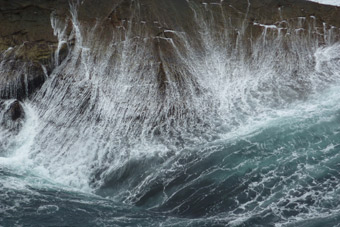
Photo: Annie Cattrell |
I was first introduced to the oceanographic term the ‘Fetch’ while visiting I.C.I.T (International Centre for Island Technology) on Orkney during a residency I undertook hosted by the Pier Arts Centre in Stromness during 2010.
The Fetch (length) of a wave can be incredibly long. For example, it could stretch from the east coast of the United States, where it might originate, and travel uninterrupted by land mass across the Atlantic Ocean, arriving on the shores of the west coast of Scotland, in particular the Orkneys, where it would then be forced to break against the coastline.
The simple equation relating to this phenomena is that the length of a wave determines the power and energy of it.
As a consequence scientists and technologists based in Orkney are trying to harness the waves to create renewable energies for the future. The uninterrupted ‘Fetch’ length of a wave seems like a strong natural metaphor for cause and effect. The behaviour of oceans, seas and weather generally would appear to override any political or territorial boundaries and constraints, reminding us of the larger rhythms of earth systems that can so easily be damaged and altered by different types of human made pollutants.
'Fetch' can also mean to go and collect and is to some extent predictive and about a future intention. Collecting and harnessing ideas and ways of living more sustainably would seem to be navigating in the right direction!
If not now, when?, Primo Levi
Wallace Heim, writer, co-editor of ashdendirectory.org.uk
a stranger's compass
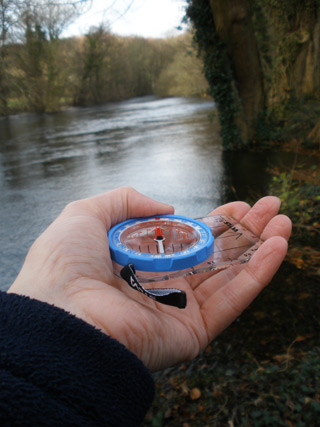
Photo: Wallace Heim |
Walking an unfamiliar Cumbrian fell with a compass, often without a map, links me to the land in a special way. The invisible, magnetic north that spins into place on the device is often perplexing and counter-intuitive. However reassuring it is to know there are vast forces of geology beyond any I can see, forces that co-ordinate my safe passage, I still have to negotiate the land right in front of me: that granite face, that swamped mire, that fast river. There is no picture in which to find myself, only wit, the land and the pull of a distant polar force.
A few times, I've come across a dropped compass. There's a moment when clearing the mud from its face when I wonder whether it was left behind because it was broken, or not believed. Is the north that was found in a stranger's hand the same as in mine?
I don't think sustainability can be likened directly to a compass, as if there was a pole of certainty to it. There are orientations that guide, but they fluctuate with a landscape that is continually shifting. The incremental decisions made in response to immediate conditions themselves change the situation, alter what is possible to do. I see sustainability as a response to change, one that keeps alive the capacity to respond to further change. What kind of compass would show this light-footed improvisation that makes sure those in the future can navigate their own way?
Walking with a stranger's compass comes closer as a metaphor. The compass is given, handed over, and it connects me to those I will never know, while helping me cross the land that I am in. The instruction is not reliable; maybe not safe. Or maybe it is, and the coordinates are sharper than on my own compass, signalling a clearer route. Is it pulling me in a direction I couldn't have imagined? This uncertain magnetism invigorates the walk. One day, I'll leave my compass behind.
Alison Turnbull, visual artist, born in Bogotà, working in London
the Spanish dehesa
I first saw the Spanish dehesa on a trip to Extremadura some twenty years ago. We drove for over fifty miles without passing another car and the temperature soared to 53º C. It was difficult to believe we were in Western Europe and not in the plains of the American west or crossing an African savannah. I’ve been back every year since, walking and experiencing this unique eco-system in all kinds of weather, under all sorts of light.
Rather like the evocative Spanish term duende, used in the performing arts to mean ‘soul’ or ‘spirit’, dehesa is a difficult word to translate. Meadow, wooded pastureland and grazing operation, it is a sylvo-pastoral system that covers 20,000 square kilometres, mostly in southwest Spain but also stretching into Portugal and Morocco. It is one of the oldest created landscapes in Europe – a cultural landscape if you like - just how ancient no one quite knows, but certainly several centuries, and it remains an outstanding example of intelligent husbandry. It is beneficial to the needs of human beings but also hospitable to a whole variety of other creatures, including many rare butterflies.
The grassed zones in between the oak trees are famously home to acorn-fed Iberian pigs that produce the most wonderful ham in the world. Honey, cheese, cork and charcoal are all products of the dehesa. It is an area of exceptional bio-diversity - for instance it is the wintering ground for most of Europe’s population of Grus grus, the common crane.
The dehesa is special in that it is an area where maximum exploitation sits side by side with maximum conservation. It’s man-made and it’s right here in Europe.
Solitaire Townsend, co-founder of Futerra, the sustainability communications agency
teenaged sex, Tatiana's 'Weather Speech', advice to the dude
I’ve heard hundreds of definitions and metaphors for sustainability. For a decade my company Futerra has been communicating this precious, complicated, simple idea in communities, through brands and across continents. So I’ve picked three favourite metaphors which sandwich the sublime between two moments of the ridiculous.
The first is courtesy of my co-founder at Futerra the guru, professional comic and activist Ed Gillespie. This one comes with humour warning...
"Sustainability is like teenage sex. Everybody says they are doing it, but very few actually are. And those which are doing it – are doing it wrong."
Ed loves opening conference speeches with that one.
The second isn’t really a metaphor but rather a poetic description of climate change. It’s the famous ‘Weather Speech’ by Titania from Shakespeare’s A Midsummer Night’s Dream (Act 2, Scene 1):
The winds, piping to us in vain,
As in revenge, have suck'd up from the sea
Contagious fogs; which falling in the land
Have every pelting river made so proud
That they have overborne their continents:
The ox hath therefore stretch'd his yoke in vain,
The ploughman lost his sweat, and the green corn
Hath rotted ere his youth attain'd a beard;
The fold stands empty in the drowned field,
And crows are fatted with the murrion flock;
The nine men's morris is fill'd up with mud,
And the quaint mazes in the wanton green
For lack of tread are undistinguishable:
The human mortals want their winter cheer;
No night is now with hymn or carol blest:
Therefore the moon, the governess of floods,
Pale in her anger, washes all the air,
That rheumatic diseases do abound:
And thorough this distemperature we see
The seasons alter: hoary-headed frosts
Far in the fresh lap of the crimson rose,
And on old Hiems' thin and icy crown
An odorous chaplet of sweet summer buds
Is, as in mockery, set: the spring, the summer,
The childing autumn, angry winter, change
Their wonted liveries, and the mazed world,
By their increase, now knows not which is which:
And this same progeny of evils comes
From our debate, from our dissension;
We are their parents and original.
That in the 1590’s Shakespeare wrote the most chilling description of climatic upheaval inspired Ed and I to shoot a short film of the speech. Called The Season’s Alter it stars a young Keira Knightly.
The final example is my most often used. When asked to define or explain sustainable development I don’t call upon the great Bard, but rather upon Bill S. Preston, Esquire and Ted Theodore Logan:
"Be excellent to each other, and party on dudes."
published in 2011
|
Our DVD of James Marriott, Carolyn Steel, Zoë Svendsen and Ansuman Biswas presenting their metaphors is here.
The project continues with new metaphors added throughout 2011 here on the Ashden Directory and on Ashdenizen. Ashdenizen blogs:
Metaphors to continue to live by
New metaphors for sustainability would need to range from "resilience" and "symbiosis" to "anxiety"
|